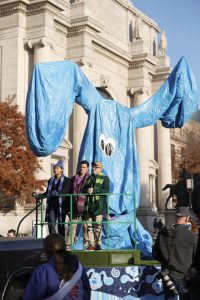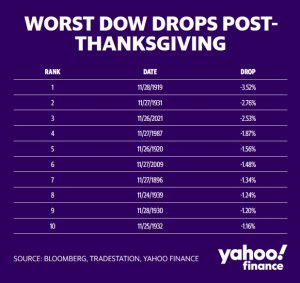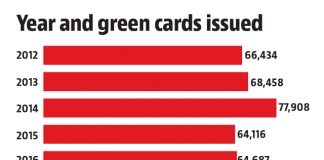NOVEMBER 26, 2021

People ride the temporarily deflated Blues Clues float during the 95th Macy’s Thanksgiving Day Parade on November 25, 2021 in New York City. (Photo by Michael Loccisano/Getty Images)
Shoppers typically bear the brunt of Black Friday frenzy while clamoring over discounted holiday merchandise, but concerns over the new COVID variant gave investors and traders a dollop of holiday volatility Friday.
The Dow Jones Industrial Index settled down 905 points (2.53%) in its worst post-Thanksgiving Day performance since 1931. The S&P 500 and the Nasdaq Composite, meanwhile, turned in their worst-ever returns post-Turkey Day.

Interactive Brokers Chief Strategist Steve Sosnick told Yahoo Finance Live that investors “had really gotten very sanguine about the risks in the market.”
Sosnick added that investors need to prepare for events like Friday ahead of time. Otherwise, protection becomes expensive just when it’s needed.
“I don’t want to overreact one way or the other too much today because hopefully, you shouldn’t be too spooked by a drawdown of 2% to 4% in your holdings,” he said. “But I think this is the reminder that says, ‘Okay, if a day like today spooks me, I’ve got too much risk on.'”
The most recently brutal Black Friday took place on Friday November 27, 2009, when concerns over a sovereign debt crisis erupted with news that Dubai World threatened to default on $26 billion in debt.
As investors faced the largest potential restructuring since Argentina in 2001, Dow futures careened as much as 4.3% overnight but found their footing as Europe opened early Friday morning. Then it was off to the races in the U.S., with the Dow recovering all the losses by the following Tuesday — setting up a Santa Claus rally for year-end.
At the time, the Federal Reserve’s first round of quantitative easing (QE1) was still a tailwind, as it is now. And while the sovereign debt crisis would wreak havoc on global markets the following year, 2009 ended quietly with gains of 18.9%
This year, Black Friday shaped up a bit differently: Dip buyers in stocks were nowhere to be found in Friday’s abbreviated session. The three majors plus the Russell 2000 closed near the session lows. A surge into bonds, meanwhile, caused the biggest drop in long-term yields since the original COVID carnage in March 2020.
History provides some clues as to what comes next, as the Dow has sold off 0.5% or more 23 times on the day after Thanksgiving in its 125-year history. In those years, the Dow averaged a return of 4.2% up to Black Friday and lost -0.1% into year-end, producing an average return of 2.3%.
And with the S&P 500 up 25% before Thanksgiving this year, it becomes worthwhile to break down the results further. There were 13 years of .5% Black Friday drops in which the Dow was positive going into Thanksgiving, boasting average returns of 16.9%. Both the average and median gains into year-end for this group were 2.7%. The only year to suffer a decline was 1896 (incidentally, the Dow had only been in use for about six weeks at the time).
A few other eventful years make the list, such as 1987 — a time in which the Dow suffered its greatest ever one-day loss of 22.6% on October 19, 1987, dubbed “Black Monday.” After a 1.87% loss on the Black Friday following Thanksgiving, the Dow went on to rally 1.5% into year-end.
Courtesy: Yahoo! Finance










































































































